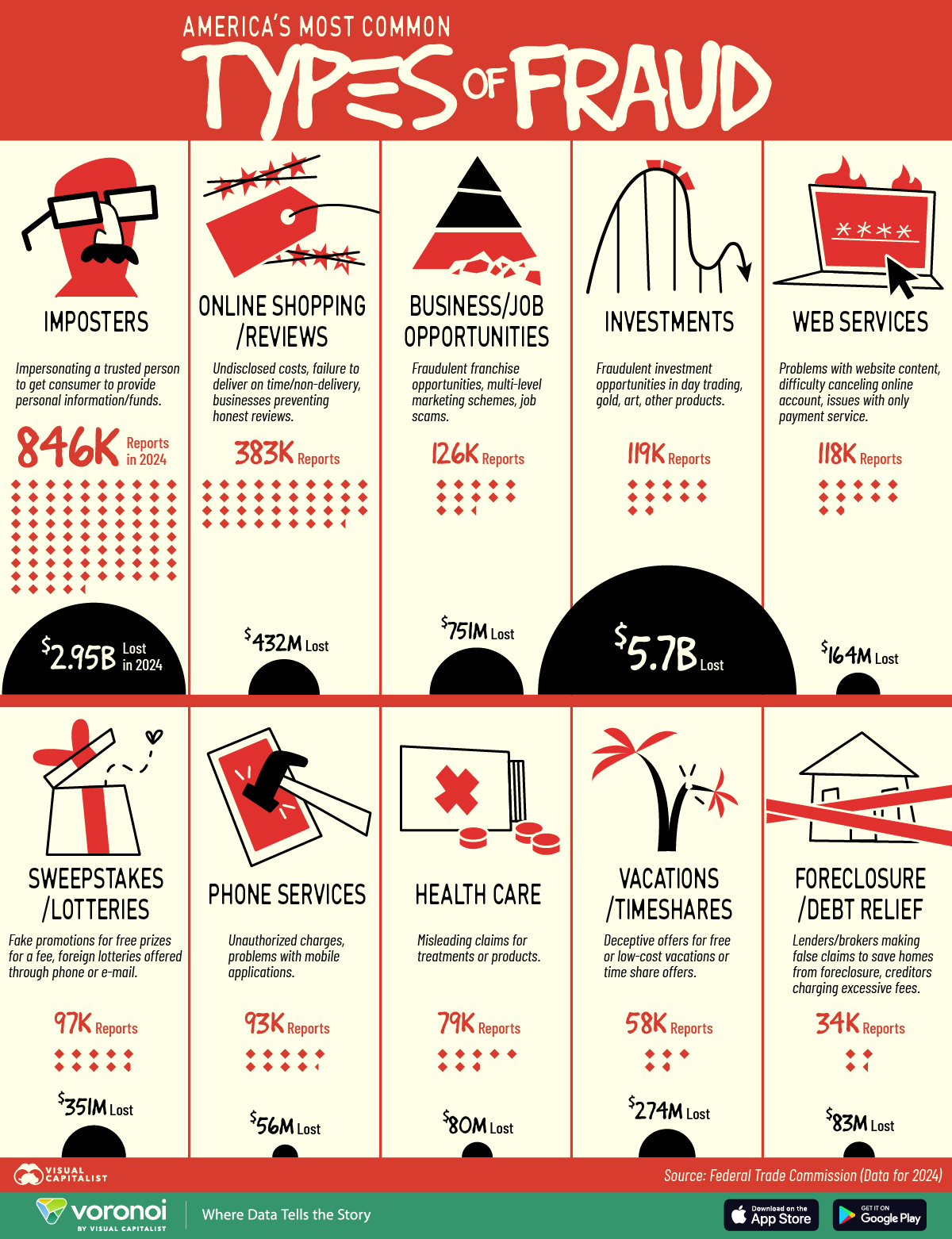![]()
See this visualization first on the Voronoi app.

Use This Visualization
Visualizing Types of Fraud in the U.S.
This was originally posted on our Voronoi app. Download the app for free on iOS or Android and discover incredible data-driven charts from a variety of trusted sources.
Americans are losing more money to scams than ever before. The Federal Trade Commission (FTC) estimates that Americans lost $12.5 billion to fraud schemes in 2024, up $2.5 billion from the previous year.
In 2023, consumers around the world lost almost half a trillion dollars to scams.
While certain scams were much more commonly reported, other types led to bigger financial losses for consumers.
This visualization shows the 10 most common types of fraud in the U.S. by the number of reports made to the FTC in 2024, and the total dollar value lost from each type of fraud.
Data comes from the FTC and is updated as of March 2025.
What Type of Fraud is the Most Common?
Below, we show the top 10 most commonly reported fraud types to the FTC, the total dollar value lost from each type of fraud, and the median loss per incident.
| Rank | Category | Number of reports | Median loss per incident | Total losses in 2024 |
|---|---|---|---|---|
| 1 | Imposter scams | 845,806 | $800 | $2.95 billion |
| 2 | Online shopping and negative reviews | 383,441 | $130 | $432 million |
| 3 | Business and job opportunities | 126,217 | $2,250 | $751 million |
| 4 | Investment related | 118,960 | $9,196 | $5.70 billion |
| 5 | Internet services | 118,261 | $300 | $164 million |
| 6 | Prizes, sweepstakes and lotteries | 97,350 | $1,000 | $351 million |
| 7 | Telephone and mobile services | 92,520 | $240 | $56 million |
| 8 | Health care | 78,763 | $283 | $80 million |
| 9 | Travel, vacations, timeshare plans | 58,347 | $922 | $274 million |
| 10 | Mortgage foreclosure relief, debt management | 34,159 | $1,500 | $83 million |
Imposter scams—where fraudsters pose as government officials, friends, coworkers, or other trusted parties to steal money or personal information—were the most frequently reported type of fraud in the U.S. last year, with over 840,000 cases filed with the FTC.
This cost consumers almost $3 billion in losses last year.
However, while imposter scams were the most common, investment-related scams led to the biggest financial losses, costing Americans a total of $5.7 billion. The median loss per victim exceeded $9,000.
According to the FTC, scams through email made up the highest number of reports while scams through social media had the highest losses.
Text message scams are also common, making up 22% of all fraud reports to the FTC in 2022.
Types of Fraud
A full list of all fraud types can be found on the FTC website.
- Imposter scams: Someone pretends to be a trusted person to get consumer to send money/give personal information
- Online shopping/negative reviews: Undisclosed costs, failure to deliver on time, non-delivery, business preventing honest reviews
- Business/job opportunities: Fraudulent franchise opportunities, multi-level marketing schemes, job scams
- Investment related: Fraudulent investment opportunities in day trading, gold, art, other products
- Internet services: Problems with website content, difficulty canceling online account, issues with payment service, undisclosed charges
- Prizes, sweepstakes and lotteries: Promotions for free prizes for a fee, foreign lotteries offered through phone or e-mail
- Telephone and mobile services: Unauthorized charges, problems with mobile applications
- Health care: Fraudulent, misleading or deceptive claims for treatments or products
- Travel, vacations, timeshare plans: Deceptive offers for free or low-cost vacations, misleading time share offers
- Mortgage foreclosure relief, debt management: Lenders/brokers making false promises to save consumers’ homes from foreclosure, credit organizations charging excessive fees
Learn More on the Voronoi App ![]()
To learn more about common scams, check out this graphic that visualizes companies are impersonated most often in online scams.
The post Ranked: Most Common Types of Fraud in America appeared first on Visual Capitalist.